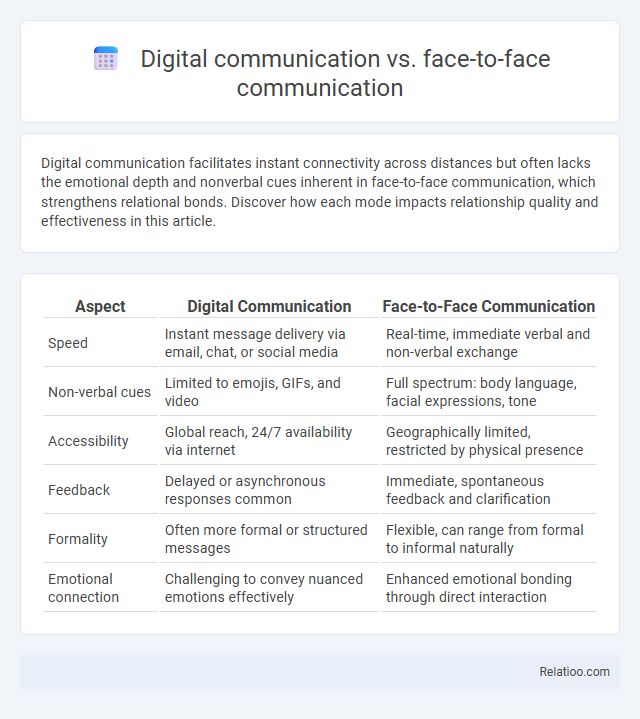Digital communication facilitates instant connectivity across distances but often lacks the emotional depth and nonverbal cues inherent in face-to-face communication, which strengthens relational bonds. Discover how each mode impacts relationship quality and effectiveness in this article.
Table of Comparison
| Aspect | Digital Communication | Face-to-Face Communication |
|---|---|---|
| Speed | Instant message delivery via email, chat, or social media | Real-time, immediate verbal and non-verbal exchange |
| Non-verbal cues | Limited to emojis, GIFs, and video | Full spectrum: body language, facial expressions, tone |
| Accessibility | Global reach, 24/7 availability via internet | Geographically limited, restricted by physical presence |
| Feedback | Delayed or asynchronous responses common | Immediate, spontaneous feedback and clarification |
| Formality | Often more formal or structured messages | Flexible, can range from formal to informal naturally |
| Emotional connection | Challenging to convey nuanced emotions effectively | Enhanced emotional bonding through direct interaction |
Introduction to Communication Modes
Digital communication enables instantaneous exchange through emails, social media, and video calls, broadening your reach beyond geographical limits. Face-to-face communication fosters richer interactions via body language, tone, and immediate feedback, enhancing emotional connection and understanding. Combining both modes effectively strengthens relationships by balancing convenience and personal engagement in various contexts.
Defining Digital Communication
Digital communication involves exchanging information through electronic devices such as smartphones, computers, and tablets, enabling instant messaging, emails, and video calls. Unlike face-to-face communication, it lacks physical presence and nonverbal cues, requiring clear and concise messaging to avoid misunderstandings. Your ability to effectively navigate digital platforms enhances connection despite the absence of direct interpersonal interaction.
Understanding Face-to-Face Communication
Face-to-face communication offers nuanced understanding through visual cues, body language, and immediate feedback, enabling stronger emotional connections and clearer message interpretation. Digital communication lacks the full spectrum of non-verbal signals, which can lead to misunderstandings and reduced empathy between participants. The depth of connection in face-to-face interactions enhances trust and shared meaning, making it essential for complex conversations and relationship-building.
Key Differences Between Digital and Face-to-Face Communication
Digital communication relies on electronic devices and platforms to transmit messages instantly across distances, involving text, video calls, and social media, while face-to-face communication occurs in person, allowing for immediate feedback and rich non-verbal cues like body language and facial expressions. Key differences include the presence of physical context and emotional nuance in face-to-face interactions, which enhance understanding and relationship-building, contrasted with the convenience, speed, and accessibility of digital communication that can sometimes lead to misinterpretation or reduced personal connection. Connection in communication is influenced by the medium; face-to-face enables deeper emotional bonds through direct interaction, whereas digital communication often requires extra effort to maintain engagement and authenticity.
Advantages of Digital Communication
Digital communication offers unparalleled convenience, allowing instant interaction across global distances without geographical constraints. It supports multimedia integration, enabling richer information exchange through text, images, video, and audio. Enhanced accessibility and real-time collaboration tools boost productivity and foster continuous connectivity in both personal and professional environments.
Benefits of Face-to-Face Communication
Face-to-face communication enhances connection through non-verbal cues like body language and facial expressions, fostering deeper understanding and trust. Your ability to read emotions and respond immediately helps prevent misunderstandings and builds stronger relationships. This direct interaction promotes engagement and collaboration that digital communication often lacks.
Limitations and Challenges of Digital Communication
Digital communication often faces limitations such as reduced nonverbal cues, leading to misunderstandings and weaker emotional connections compared to face-to-face interaction. Technical issues like poor internet connectivity or platform glitches disrupt seamless conversations and decrease overall communication effectiveness. Privacy concerns and information security risks also pose significant challenges, impacting trust and openness in digital exchanges.
Drawbacks of Face-to-Face Communication
Face-to-face communication often requires physical presence, limiting flexibility and accessibility, especially in remote or global contexts. It can also lead to misunderstandings due to nonverbal cues varying across cultures, causing potential miscommunication. Moreover, face-to-face interactions may increase social anxiety and pressure, hindering effective expression for some individuals.
Impact on Relationships and Social Skills
Digital communication offers convenience but can limit nonverbal cues crucial for deep emotional connection and nuanced social interactions. Face-to-face communication enables richer, more authentic exchanges that enhance empathy, trust, and social skills development. Your relationships benefit most when combining digital tools for accessibility with in-person interactions fostering genuine connection and social competence.
Choosing the Right Communication Method
Choosing the right communication method depends on your goals and context, where digital communication offers speed and convenience for quick information exchange, while face-to-face communication provides richer emotional cues and fosters deeper trust. Effective connection requires balancing immediacy and intimacy, recognizing that digital tools excel in accessibility but may lack the nuance of in-person interactions. Understanding the strengths of each method helps you optimize collaboration, engagement, and relationship-building in personal and professional environments.

Infographic: Digital communication vs Face-to-face communication
 relatioo.com
relatioo.com